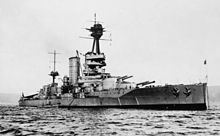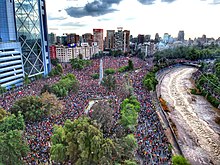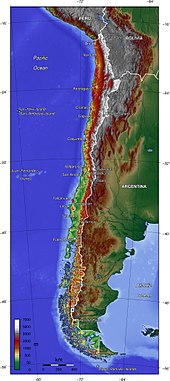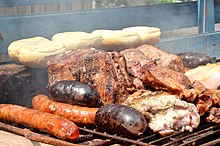Chile
Chile had a population of 17.5 million as of the latest census in 2017 and has a territorial area of 756,102 square kilometers (291,933 sq mi),[10][3] sharing borders with Peru to the north, Bolivia to the northeast, Argentina to the east, and the Drake Passage to the south.
In the 20th century, up until the 1970s, Chile underwent a process of democratization[11][12] and experienced rapid population growth and urbanization,[13] while relying increasingly on exports from copper mining to support its economy.
[14][15] During the 1960s and 1970s, the country was marked by severe left-right political polarization and turmoil, which culminated in the 1973 Chilean coup d'état that overthrew Salvador Allende's democratically elected left-wing government.
This was followed by a 16-year right-wing military dictatorship under Augusto Pinochet, in which the 1980 Chilean Constitution was made with the consultancy of the Ortúzar Commission[16][17] as well as several political and economic reforms,[18] and resulted in more than 3,000 deaths or disappearances.
[40][verification needed] Cut off to the north by desert, to the south by the Mapuche, to the east by the Andes Mountains, and to the west by the ocean, Chile became one of the most centralized, homogeneous territories in Spanish America.
With Carrera in prison in Argentina, O'Higgins and anti-Carrera cohort José de San Martín, hero of the Argentine War of Independence, led an army that crossed the Andes into Chile and defeated the royalists.
In this regard he tasked the Scottish naval officer, Lord Thomas Cochrane, in a letter dated 12 November 1821, expressing his plan to conquer Guayaquil, the Galapagos Islands, and the Philippines.
The economy began to boom due to the discovery of silver ore in Chañarcillo, and the growing trade of the port of Valparaíso, which led to conflict over maritime supremacy in the Pacific with Peru.
The Boundary treaty of 1881 between Chile and Argentina confirmed Chilean sovereignty over the Strait of Magellan but also made the country to renounce to its claims in the rest of East Patagonia after a dispute that started in 1842.
[49][50] By relinquishing power to a democratically elected successor, Ibáñez del Campo retained the respect of a large enough segment of the population to remain a viable politician for more than thirty years, in spite of the vague and shifting nature of his ideology.
Under the slogan "Revolution in Liberty", the Frei administration embarked on far-reaching social and economic programs, particularly in education, housing, and agrarian reform, including rural unionization of agricultural workers.
[54] Allende's program included advancement of workers' interests,[54][55] replacing the judicial system with "socialist legality",[56] nationalization of banks and forcing others to bankruptcy,[56] and strengthening "popular militias" known as MIR.
After Pinochet obtained rule of the country, several hundred committed Chilean revolutionaries joined the Sandinista army in Nicaragua, guerrilla forces in Argentina or training camps in Cuba, Eastern Europe and Northern Africa.
[74] In the late 1980s, largely as a result of events such as the 1982 economic collapse[75] and mass civil resistance in 1983–88, the government gradually permitted greater freedom of assembly, speech, and association, to include trade union and political activity.
On 5 August 2010, the access tunnel collapsed at the San José copper and gold mine in the Atacama Desert near Copiapó in northern Chile, trapping 33 men 700 meters (2,300 ft) below ground.
The Andes, split in two and whose eastern arm runs through Bolivia, has a high altitude and volcanic activity, which has allowed the formation of the Andean altiplano and salt structures as the Salar de Atacama, due to the gradual accumulation of sediments over time.
[106] Some of Chile's flora has an Antarctic origin due to land bridges which formed during the Cretaceous ice ages, allowing plants to migrate from Antarctica to South America.
[105] Owing to the vicinity of the Humboldt Current, ocean waters abound with fish and other forms of marine life, which in turn support a rich variety of waterfowl, including several penguins.
[105] The current Constitution of Chile was drafted by Jaime Guzmán in 1980[113] and subsequently approved via a national plebiscite—regarded as "highly irregular" by some observers[26]—in September of that year, under the military dictatorship of Augusto Pinochet.
Gen. Gustavo González Jure is the head of the national police force of 40,964[123] men and women who are responsible for law enforcement, traffic management, narcotics suppression, border control, and counter-terrorism throughout Chile.
The coat of arms depicts the two national animals: the condor (Vultur gryphus, a very large bird that lives in the mountains) and the huemul (Hippocamelus bisulcus, an endangered white tail deer).
[133][134][135] The think tank The Heritage Foundation states that Chile has the highest degree of economic freedom in South America (ranking 22nd worldwide), owing to its independent and efficient judicial system and prudent public finance management.
[169] Some other major agriculture products of Chile include pears, onions, wheat, maize, oats, garlic, asparagus, beans, beef, poultry, wool, fish, timber and hemp.
Viña del Mar, Valparaíso's more affluent northern neighbor, is popular because of its beaches, casino, and its annual song festival, the most important musical event in Latin America.
[180] Since the mid-1990s, there has been a significant improvement in the country's roads, through bidding processes that allowed the construction of an efficient road network, with emphasis on the duplication of continuous 1,950 km (1,212 mi) of the Panamerican Highway (Chile Route 5) between Puerto Montt and Caldera (in addition to the planned duplication in the Atacama Desert area),[181] the excerpts in between Santiago, Valparaiso and the Central Coast, and the northern access to Concepción and the large project of the Santiago urban highways network, opened between 2004 and 2006.
[200] A public health booklet from the University of Chile states that 35% of the population is of Caucasian origin; "predominantly White" Mestizos are estimated to amount to a total of 65%, while Native Americans (Amerindians) comprise the remaining 5%.
In the late 19th century, liberal policies (the so-called Leyes laicas or "lay laws") started to reduce the influence of the clergy and the promulgation of a new Constitution in 1925 established the separation of church and state.
From the 1950s to the 1970s, native folk musical forms were revitalized with the Nueva canción chilena movement led by composers such as Violeta Parra, Raúl de Ramón and Pedro Messone, which was also associated with political activists and reformers such as Víctor Jara, Inti-Illimani, and Quilapayún.
Among the list of other Chilean poets are Carlos Pezoa Véliz, Vicente Huidobro, Gonzalo Rojas, Pablo de Rokha, Nicanor Parra, Ivonne Coñuecar and Raúl Zurita.
Secondly, its tangible heritage consists of those buildings, objects and sites of archaeological, architectural, traditional, artistic, ethnographic, folkloric, historical, religious or technological significance scattered through Chilean territory.














































